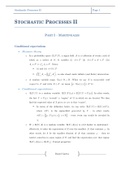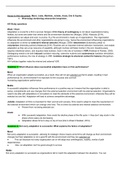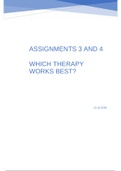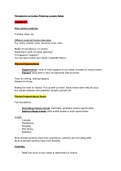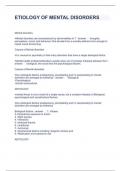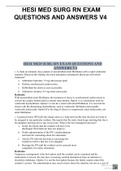Quantitative Methods in Media and Communication
* exam preparation *
Important values:
Significance (p-value)
P-value = the probability that the null hypothesis is true. A low P-value means that the
results are replicable. It shows that the effect is large or that the result is of major,
theoretical, clinical or practical importance.
Kurtosis and Skewness (loose guidelines)
Kurtosis = how flat or high a peak is in the data. | _
Skewness = if it Is distributed more to the left or to the right. <->
- The closer to zero the better!
- Loose guidelines: any value between -3 and 3 is allowed.
- Moderate guidelines: any value between -2 and 2 is allowed.
- Strict guidelines: any value between -1 and 1 is allowed.
A priori assumptions (N, continuous)
A priori = what you do before you start with the factor analysis
- If the scale contains at least 3 items/statements that will be included in the factor
analysis
- If the items are measured on a continuous level
- If they are normally distributed
- If your sample size is bigger than 150
-> factor analysis = finding an underlying concept and giving it a name. It might than be
easier to group concepts/answers.
A posteriori assumptions
Posteriori = assumptions that are being made after the factor analysis
- If the correlations are not only different from 0, but also mostly above 0.30
- If the Kaiser-Meyer-Olkin measure of sampling adequacy (KMO) is 0.60 or above.
KMO = measure of the proportion of variance among variables that might be
common variance
- Of the Bartlett’s test of sphericity is significant
KMO
KMO = Kaiser-Meyer-Olkin, measure of the proportion of variance among variables that
might be common variance.
Bartlett-test
Bartlett-test = used to test homoscedasticity (if all the random variables have the same finite
variance), if multiple samples are from populations with equal variances.
, -> Variance = the expectation of the squared deviation of a random variable from its
population mean or sample mean. It is a measure of how far a set of numbers is spread out
from their average value.
Eigenvalue, Kaiser’s criterion
Kaiser’s criterion = the number of components with an Eigenvalue of 1 or more
-> Eigen value = the factor by which the eigenvector (nonzero vector that changes at most by
a scalar factor when that linear transformation is applied to it) is scaled
Reliability (and when to delete items from further analysis)
Reliability = the consistency of a measure. A highly reliable measure is more consistent than
a measure with low reliability. It is determined by obtaining the proportion of systematic
variation in a scale, which can be done by determining the association between the scores
obtained from different administrations of the scale.
-> Validity = the extent to which the instrument yields the same results over multiple trials.
Correlation
Pearson’s R = indicates a positive (1) or negative correlation (-1)
Cohen’s guidelines:
- Small = 0.10 to 0.29
- Medium = 0.30 to 0.49
- Large = 0.50 to 1
Values you need to find:
Factor loadings (how to decide which item belongs to which Factor/Subscale/Component)
Factor loading = can be thought of as the correlation between an item and given factor.
-> Check the a posteriori
What to do: determine the amount of relevant factors (do the items form one overall scale
or several subscales?) aka, based on the number of components with an Eigenvalue of 1 or
more -> determining the items belonging to each component, as well as their factor loadings
* exam preparation *
Important values:
Significance (p-value)
P-value = the probability that the null hypothesis is true. A low P-value means that the
results are replicable. It shows that the effect is large or that the result is of major,
theoretical, clinical or practical importance.
Kurtosis and Skewness (loose guidelines)
Kurtosis = how flat or high a peak is in the data. | _
Skewness = if it Is distributed more to the left or to the right. <->
- The closer to zero the better!
- Loose guidelines: any value between -3 and 3 is allowed.
- Moderate guidelines: any value between -2 and 2 is allowed.
- Strict guidelines: any value between -1 and 1 is allowed.
A priori assumptions (N, continuous)
A priori = what you do before you start with the factor analysis
- If the scale contains at least 3 items/statements that will be included in the factor
analysis
- If the items are measured on a continuous level
- If they are normally distributed
- If your sample size is bigger than 150
-> factor analysis = finding an underlying concept and giving it a name. It might than be
easier to group concepts/answers.
A posteriori assumptions
Posteriori = assumptions that are being made after the factor analysis
- If the correlations are not only different from 0, but also mostly above 0.30
- If the Kaiser-Meyer-Olkin measure of sampling adequacy (KMO) is 0.60 or above.
KMO = measure of the proportion of variance among variables that might be
common variance
- Of the Bartlett’s test of sphericity is significant
KMO
KMO = Kaiser-Meyer-Olkin, measure of the proportion of variance among variables that
might be common variance.
Bartlett-test
Bartlett-test = used to test homoscedasticity (if all the random variables have the same finite
variance), if multiple samples are from populations with equal variances.
, -> Variance = the expectation of the squared deviation of a random variable from its
population mean or sample mean. It is a measure of how far a set of numbers is spread out
from their average value.
Eigenvalue, Kaiser’s criterion
Kaiser’s criterion = the number of components with an Eigenvalue of 1 or more
-> Eigen value = the factor by which the eigenvector (nonzero vector that changes at most by
a scalar factor when that linear transformation is applied to it) is scaled
Reliability (and when to delete items from further analysis)
Reliability = the consistency of a measure. A highly reliable measure is more consistent than
a measure with low reliability. It is determined by obtaining the proportion of systematic
variation in a scale, which can be done by determining the association between the scores
obtained from different administrations of the scale.
-> Validity = the extent to which the instrument yields the same results over multiple trials.
Correlation
Pearson’s R = indicates a positive (1) or negative correlation (-1)
Cohen’s guidelines:
- Small = 0.10 to 0.29
- Medium = 0.30 to 0.49
- Large = 0.50 to 1
Values you need to find:
Factor loadings (how to decide which item belongs to which Factor/Subscale/Component)
Factor loading = can be thought of as the correlation between an item and given factor.
-> Check the a posteriori
What to do: determine the amount of relevant factors (do the items form one overall scale
or several subscales?) aka, based on the number of components with an Eigenvalue of 1 or
more -> determining the items belonging to each component, as well as their factor loadings


